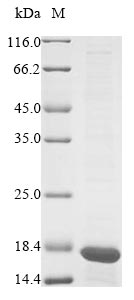Recombinant Mouse Prohibitin (Phb) is produced in an E.coli expression system and contains a partial sequence spanning amino acids 174 to 272. The protein carries an N-terminal 10xHis-tag, which helps with purification and detection. SDS-PAGE analysis shows the product achieves greater than 85% purity, which appears adequate for most research applications. It's supplied as a research-use-only reagent, though no endotoxin level has been specified.
Prohibitin represents a highly conserved protein that seems central to cellular processes like cell cycle regulation and apoptosis. The protein plays what appears to be a crucial role in maintaining mitochondrial integrity and participates in various signaling pathways. Research often focuses on Prohibitin's potential involvement in cell proliferation and aging, making it an important target for those trying to understand cellular homeostasis.
Potential Applications
Note: The applications listed below are based on what we know about this protein's biological functions, published research, and experience from experts in the field. However, we haven't fully tested all of these applications ourselves yet. We'd recommend running some preliminary tests first to make sure they work for your specific research goals.
Mouse Prohibitin is a complex mitochondrial membrane protein that requires precise folding, proper membrane association, and specific oligomerization (forming large ring complexes with Phb2) for its functional activity in mitochondrial integrity and signaling. The E. coli expression system cannot provide the necessary mitochondrial membrane environment or eukaryotic chaperones for this complex protein. The partial fragment (174-272aa) represents only the C-terminal region and lacks critical N-terminal domains essential for proper oligomerization and membrane anchoring. The N-terminal 10xHis-tag may further interfere with the protein's structural organization. The probability of correct folding with functional activity is extremely low.
1. Antibody Development and Validation
This application is suitable for generating antibodies against this specific 174-272aa region. Antibody development relies on linear epitope recognition rather than functional protein conformation. However, antibodies may not efficiently recognize the full-length, membrane-integrated Prohibitin in its native context.
2. Structural and Biophysical Characterization Studies
Basic biophysical characterization can be performed, but will not reflect native Prohibitin structure. Techniques can analyze the physical properties of this specific fragment, but results will describe a soluble peptide rather than the membrane-associated oligomeric complex.
Final Recommendation & Action Plan
This partial Prohibitin fragment (174-272aa) expressed in E. coli is fundamentally unsuitable for functional studies due to the essential requirements for membrane integration and oligomerization that cannot be met. The protein should not be used for interaction studies and functional mapping. Application 1 (antibody development) has limited utility for generating fragment-specific antibodies. Application 2 provides only basic physical characterization of the fragment itself. For reliable Prohibitin research, use a full-length protein expressed in eukaryotic systems with proper mitochondrial targeting and membrane integration capabilities.






